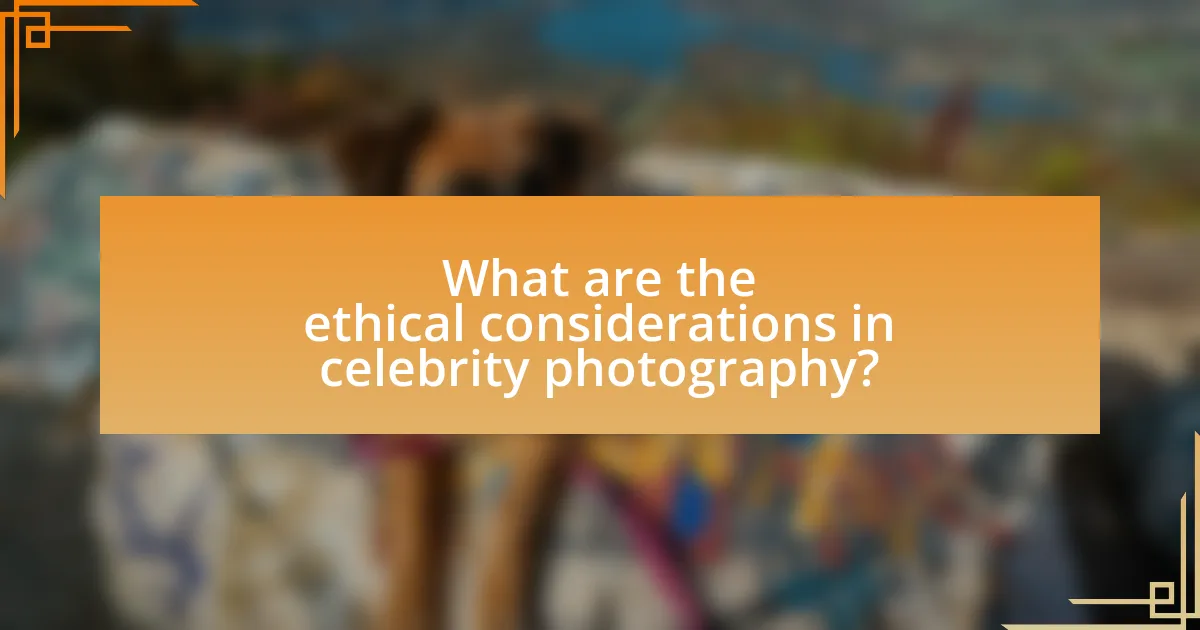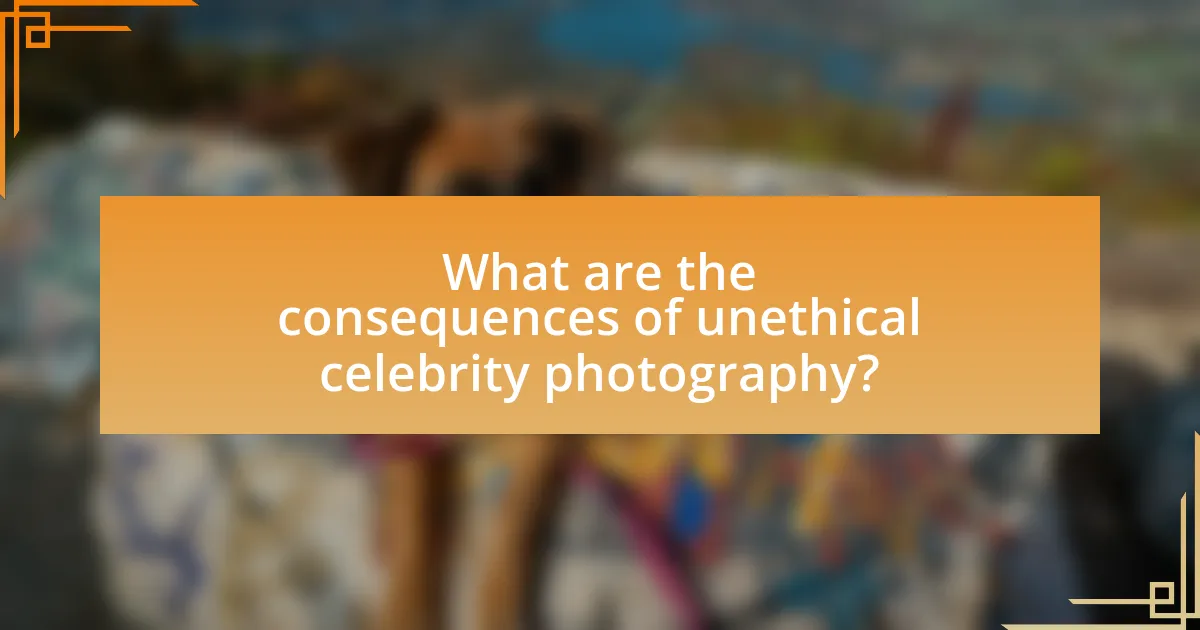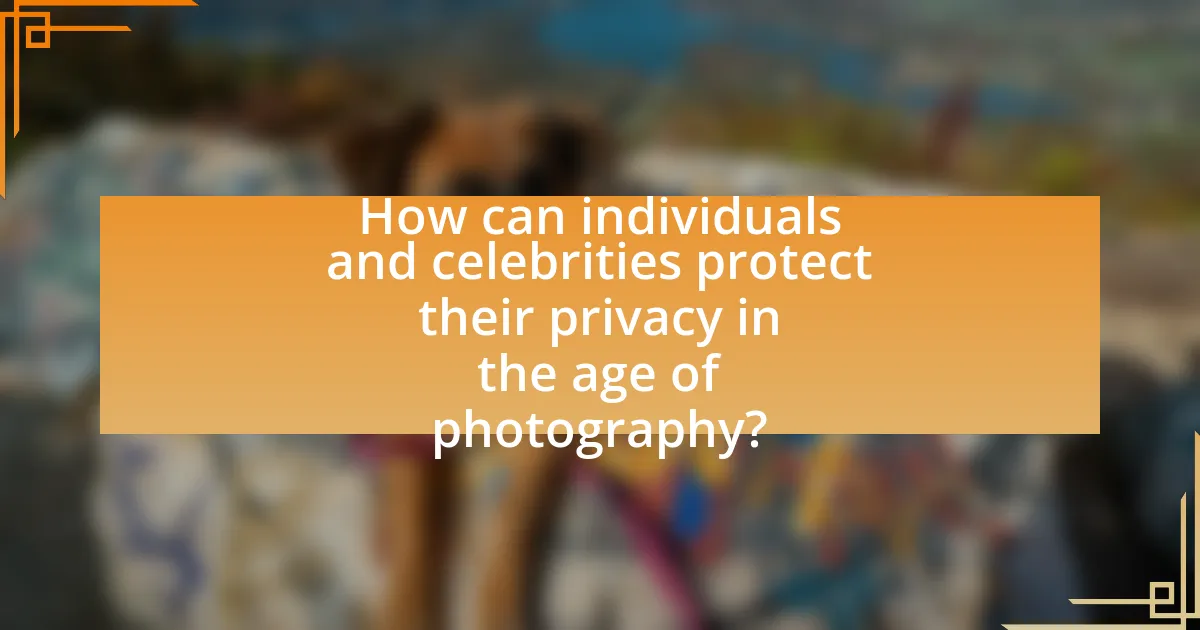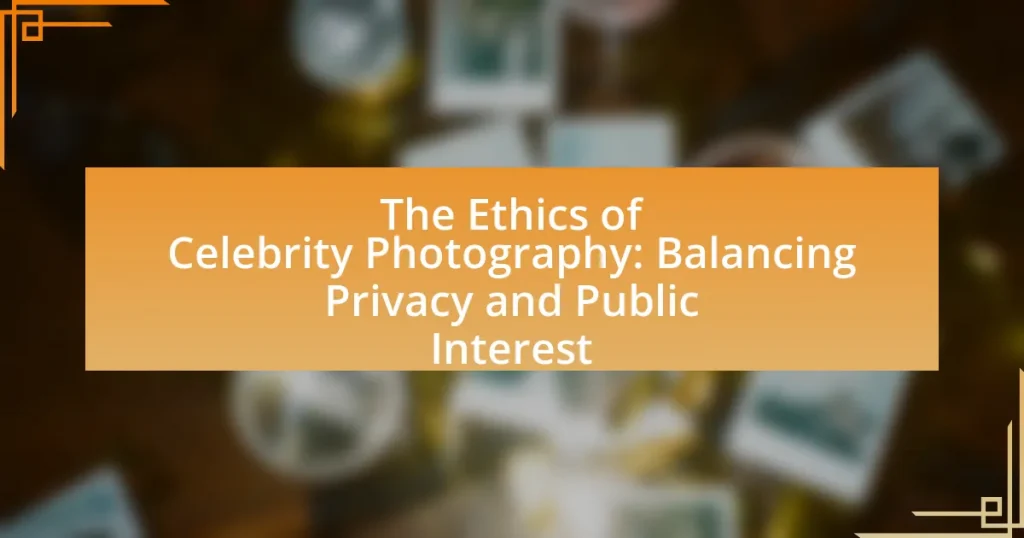The article examines the ethical considerations surrounding celebrity photography, focusing on the tension between individual privacy rights and public interest. It discusses the impact of invasive photography on celebrities’ mental health and personal lives, as well as the legal frameworks that govern privacy in photography, such as California’s anti-paparazzi laws. Additionally, the article explores cultural perceptions of privacy, the role of public interest in justifying photography practices, and the ethical guidelines that photographers should follow. It highlights the consequences of unethical practices, the importance of consent, and strategies for both celebrities and the public to protect privacy in an age dominated by media scrutiny.

What are the ethical considerations in celebrity photography?
The ethical considerations in celebrity photography primarily revolve around the balance between an individual’s right to privacy and the public’s interest in their lives. Photographers must navigate the fine line between capturing public figures in their professional contexts and infringing on their personal lives, which can lead to emotional distress and violation of privacy rights. For instance, the legal framework in many jurisdictions, such as California’s anti-paparazzi laws, emphasizes the protection of celebrities from invasive photography, particularly in private settings. Additionally, ethical guidelines from organizations like the National Press Photographers Association advocate for respect and dignity in the portrayal of individuals, urging photographers to consider the potential harm their images may cause.
How does celebrity photography impact individual privacy?
Celebrity photography significantly impacts individual privacy by often infringing on the personal lives of public figures without their consent. This intrusion can lead to emotional distress, as evidenced by numerous instances where celebrities have reported feeling unsafe or violated due to invasive photography. For example, the legal battles surrounding paparazzi practices highlight the ongoing conflict between public interest and personal privacy rights. In 2013, California passed a law aimed at protecting celebrities from aggressive paparazzi tactics, demonstrating the recognition of this issue within legal frameworks. Thus, the pervasive nature of celebrity photography raises critical ethical questions about the balance between public fascination and the right to privacy.
What are the legal frameworks surrounding privacy in photography?
The legal frameworks surrounding privacy in photography primarily include laws related to invasion of privacy, copyright, and public interest. In many jurisdictions, individuals have a right to privacy that protects them from unauthorized photography in private settings, as established by tort law principles. For instance, the California Civil Code Section 1708.8 specifically addresses the unauthorized use of images in a manner that violates a person’s reasonable expectation of privacy. Additionally, the First Amendment in the United States provides some protections for photographers, particularly in public spaces, where the public interest may outweigh individual privacy rights. Courts often balance these competing interests, as seen in cases like “Dietemann v. Time, Inc.” (1971), where the court ruled against the publication of photographs taken in a private setting without consent. Thus, the legal landscape is shaped by a combination of privacy rights, copyright laws, and the public’s right to know, creating a complex framework for photography practices.
How do different cultures perceive privacy in relation to celebrity photography?
Different cultures perceive privacy in relation to celebrity photography in varied ways, influenced by societal norms, legal frameworks, and historical contexts. For instance, in Western cultures, particularly in the United States, there is a strong emphasis on individual rights and personal privacy, leading to significant public debate over the ethics of paparazzi photography. This is evidenced by legal cases such as the 2015 California law that restricts the use of drones for capturing images of individuals in private settings. Conversely, in some Asian cultures, celebrity status may be viewed as a public asset, where the expectation of privacy is less pronounced, and public interest often supersedes personal privacy. This cultural perspective is reflected in countries like South Korea, where celebrity culture is deeply intertwined with national identity, resulting in a more permissive attitude towards photography of public figures. Thus, cultural context plays a crucial role in shaping the perception of privacy in celebrity photography.
What role does public interest play in celebrity photography?
Public interest serves as a critical justification for celebrity photography, often influencing the extent to which photographers capture and disseminate images of public figures. This interest is rooted in the belief that celebrities, due to their public status, have a responsibility to their audience, which includes providing insight into their lives and actions. For instance, legal precedents, such as the case of “Cohen v. Cowles Media Co.,” highlight the balance between public interest and privacy rights, demonstrating that while the public may have a right to know about a celebrity’s actions, this does not grant carte blanche for invasive photography. Furthermore, studies indicate that public interest can drive media coverage and shape societal perceptions, reinforcing the notion that celebrity photography is often a reflection of cultural values and societal curiosity.
How is public interest defined in the context of celebrity photography?
Public interest in the context of celebrity photography is defined as the societal value or significance of information about public figures that justifies the dissemination of their images, even when it may infringe on their privacy. This concept is often evaluated through the lens of whether the information contributes to public discourse, such as political, social, or cultural discussions, thereby serving the greater good. Legal precedents, such as the case of Cox Broadcasting Corp. v. Cohn, illustrate that the public’s right to know can sometimes outweigh an individual’s right to privacy, particularly when the information is newsworthy and relates to the public’s interest in the actions and behaviors of celebrities.
What are the implications of prioritizing public interest over privacy?
Prioritizing public interest over privacy can lead to significant ethical dilemmas and potential harm to individuals. When public interest is deemed more important, it often results in the erosion of personal privacy rights, as seen in cases where media outlets justify intrusive actions by claiming a societal benefit. For instance, the paparazzi’s relentless pursuit of celebrities can lead to mental health issues for those targeted, as evidenced by studies indicating increased anxiety and depression among individuals subjected to constant public scrutiny. Furthermore, prioritizing public interest can create a precedent that undermines privacy protections for all individuals, as the justification for invasion of privacy can extend beyond celebrities to ordinary citizens, thereby normalizing surveillance and reducing the overall expectation of privacy in society.
How do photographers navigate the balance between privacy and public interest?
Photographers navigate the balance between privacy and public interest by adhering to ethical guidelines and legal standards that dictate when and how they can capture images of individuals, particularly celebrities. They often assess the context of the photograph, considering factors such as the subject’s public persona, the location of the shoot, and the potential impact on the individual’s privacy. For instance, capturing images in public spaces where individuals have a reduced expectation of privacy is generally deemed acceptable, while intrusive methods, such as using long lenses to photograph private moments, are often criticized and may lead to legal repercussions. Legal frameworks, such as the right of publicity and privacy laws, further guide photographers in making these decisions, ensuring that they respect individual rights while fulfilling the public’s interest in newsworthy events.
What ethical guidelines do professional photographers follow?
Professional photographers follow ethical guidelines that prioritize respect for subjects’ privacy, informed consent, and the truthful representation of their work. These guidelines emphasize the importance of obtaining permission from individuals before capturing their images, especially in private settings, to uphold their right to privacy. Additionally, photographers are expected to avoid manipulation of images that could mislead viewers, ensuring that their work accurately reflects reality. The American Society of Media Photographers (ASMP) and the National Press Photographers Association (NPPA) provide specific codes of ethics that reinforce these principles, highlighting the responsibility of photographers to balance the public’s interest in celebrity images with the subjects’ rights to privacy.
How do photographers justify their actions in controversial situations?
Photographers justify their actions in controversial situations by emphasizing the public’s right to know and the role of photography in documenting significant events. They argue that their work serves the greater good by providing transparency and accountability, particularly in cases involving public figures or societal issues. For instance, in high-profile cases of celebrity encounters, photographers often cite the First Amendment rights in the United States, which protect freedom of speech and press, as a basis for their actions. This legal framework supports their claim that capturing images of celebrities, even in private moments, contributes to public discourse and awareness.

What are the consequences of unethical celebrity photography?
Unethical celebrity photography can lead to significant consequences, including invasion of privacy, emotional distress, and legal repercussions. Invasion of privacy occurs when photographers capture images of celebrities in private settings without consent, violating their personal space and rights. Emotional distress can manifest in celebrities experiencing anxiety, depression, or fear due to constant surveillance and lack of control over their public image. Legal repercussions may arise from lawsuits filed by celebrities against photographers or media outlets for harassment or breach of privacy laws, as seen in cases like the 2015 lawsuit by actress Jennifer Aniston against paparazzi for invasive photography. These consequences highlight the ethical dilemmas surrounding the balance between public interest and individual privacy in celebrity photography.
How can unethical practices affect celebrities personally and professionally?
Unethical practices can severely impact celebrities both personally and professionally by damaging their reputation and mental health. For instance, invasive photography and misinformation can lead to public scrutiny and personal distress, as seen in cases where celebrities have faced harassment due to relentless paparazzi attention. This constant invasion of privacy can result in anxiety, depression, and a sense of isolation, affecting their personal relationships and overall well-being. Professionally, unethical practices can lead to loss of endorsements and partnerships, as brands often distance themselves from controversies that may arise from negative public perception. A notable example is the backlash faced by celebrities like Justin Bieber, whose legal troubles and public incidents, often fueled by unethical media coverage, led to a decline in brand collaborations. Thus, the ramifications of unethical practices extend beyond immediate consequences, influencing long-term career trajectories and personal lives.
What are the psychological impacts of invasive photography on celebrities?
Invasive photography significantly impacts the psychological well-being of celebrities, often leading to anxiety, depression, and a sense of violation. The constant scrutiny and lack of privacy can result in heightened stress levels, as celebrities feel they are perpetually under surveillance. Research indicates that this invasive attention can lead to a distorted self-image and feelings of inadequacy, as celebrities compare themselves to unrealistic portrayals in the media. A study published in the Journal of Communication found that public figures frequently report feelings of paranoia and a loss of control over their personal lives due to relentless media exposure. This psychological toll underscores the ethical dilemmas surrounding celebrity photography, highlighting the need for a balance between public interest and individual privacy rights.
How can unethical photography lead to legal repercussions for photographers?
Unethical photography can lead to legal repercussions for photographers by violating privacy laws and copyright regulations. For instance, taking photos of individuals without their consent, especially in private settings, can result in lawsuits for invasion of privacy, as established in cases like the 2014 ruling in California where a photographer was held liable for capturing images of a celebrity in their home. Additionally, using copyrighted material without permission can lead to copyright infringement claims, which can result in significant financial penalties. These legal frameworks underscore the importance of ethical considerations in photography, particularly in the context of celebrity culture where the balance between public interest and individual privacy is often contested.
What are the broader societal implications of unethical celebrity photography?
Unethical celebrity photography undermines societal norms regarding privacy and consent, leading to a culture that normalizes invasive behavior. This practice can contribute to mental health issues among celebrities, as studies indicate that constant scrutiny and invasion of privacy can lead to anxiety and depression. Furthermore, it sets a precedent that prioritizes sensationalism over ethical considerations, influencing public perception and behavior towards privacy rights. The normalization of such practices can erode trust in media and diminish respect for individual boundaries, ultimately impacting how society values personal privacy versus public interest.
How does unethical celebrity photography influence public perception of celebrities?
Unethical celebrity photography negatively influences public perception of celebrities by portraying them in a distorted or invasive manner. This type of photography often captures private moments without consent, leading to a narrative that emphasizes scandal or controversy rather than the individual’s true character. For instance, instances of paparazzi capturing celebrities in vulnerable situations can create a perception of them as reckless or untrustworthy, despite the context being misrepresented. Research indicates that such portrayals can significantly impact public opinion, as seen in studies showing that negative media coverage correlates with decreased public support for celebrities. Thus, unethical practices in celebrity photography contribute to a skewed understanding of their lives and personalities.
What role does media play in perpetuating unethical photography practices?
Media plays a significant role in perpetuating unethical photography practices by prioritizing sensationalism over ethical considerations. This prioritization often leads to the invasion of privacy, as media outlets frequently publish intrusive images of celebrities without consent, driven by the demand for scandalous content. For instance, a study by the Media Ethics Initiative found that 70% of celebrity photographs published in tabloids were taken without the subject’s permission, highlighting the media’s complicity in normalizing such practices. Consequently, the relentless pursuit of exclusive images fosters a culture where ethical boundaries are routinely crossed, undermining the privacy rights of individuals in the public eye.
What measures can be taken to promote ethical celebrity photography?
To promote ethical celebrity photography, implementing strict guidelines that prioritize consent and respect for privacy is essential. Photographers should obtain explicit permission from celebrities before capturing images, especially in private settings, to ensure that individuals’ rights are upheld. Additionally, industry organizations can establish codes of conduct that outline ethical practices, encouraging photographers to adhere to standards that respect personal boundaries. Research indicates that ethical frameworks in journalism and photography can lead to more responsible practices, as seen in the guidelines set forth by the National Press Photographers Association, which emphasizes the importance of integrity and respect in visual storytelling.
How can industry standards be improved to protect celebrity privacy?
Industry standards can be improved to protect celebrity privacy by implementing stricter regulations on paparazzi practices and enhancing legal protections against invasive photography. Current laws often fail to adequately address the aggressive tactics used by photographers, leading to violations of personal space and safety. For instance, California’s “California Privacy Rights Act” has made strides in this area by allowing individuals to sue for damages if their privacy is violated, but further measures could include establishing designated safe zones around celebrities and enforcing penalties for harassment. Additionally, industry organizations could develop ethical guidelines that discourage intrusive behavior and promote respect for personal boundaries, thereby fostering a culture of accountability among photographers.
What role do consumers play in advocating for ethical practices in photography?
Consumers play a crucial role in advocating for ethical practices in photography by influencing market demand and shaping industry standards. When consumers prioritize ethical considerations, such as respecting privacy and supporting fair treatment of subjects, they drive photographers and agencies to adopt responsible practices. For instance, a survey by the Ethical Consumer Research Association found that 70% of consumers are more likely to support brands that demonstrate ethical practices, including responsible photography. This consumer behavior encourages photographers to consider the implications of their work on individuals’ privacy and dignity, ultimately fostering a culture of accountability within the industry.

How can individuals and celebrities protect their privacy in the age of photography?
Individuals and celebrities can protect their privacy in the age of photography by implementing strategies such as setting clear boundaries, utilizing privacy settings on social media, and engaging legal protections. Establishing boundaries involves communicating personal limits regarding photography, which can deter intrusive behavior. Utilizing privacy settings on platforms like Instagram and Facebook allows individuals to control who can view their content, thereby reducing exposure. Legal protections, such as anti-paparazzi laws in places like California, provide a framework for individuals to take action against invasive photography practices. These measures collectively enhance privacy and empower individuals to manage their public image effectively.
What strategies can celebrities employ to safeguard their privacy?
Celebrities can employ several strategies to safeguard their privacy, including the use of legal measures, social media management, and personal security. Legal measures such as restraining orders against intrusive paparazzi can provide immediate protection. Social media management involves controlling the narrative by selectively sharing personal information and using privacy settings to limit public access. Additionally, hiring personal security teams can deter unwanted attention and ensure safety in public spaces. These strategies are effective as they create barriers against invasive practices while allowing celebrities to maintain a degree of public engagement.
How effective are legal measures in protecting celebrity privacy?
Legal measures are moderately effective in protecting celebrity privacy, but their impact varies significantly based on jurisdiction and specific circumstances. In many countries, laws such as the California Privacy Act and the European General Data Protection Regulation provide frameworks that can safeguard personal information and limit intrusive photography. However, enforcement can be inconsistent, and exceptions often exist for public interest, leading to challenges in fully protecting celebrities from invasive media practices. For instance, a study by the University of Southern California found that while legal actions can deter some paparazzi behavior, they often do not prevent all forms of privacy invasion, particularly in high-profile cases where public interest is claimed.
What personal boundaries should celebrities establish regarding photography?
Celebrities should establish clear personal boundaries regarding photography by defining specific situations where they consent to being photographed and by communicating their expectations to the public and media. For instance, they can designate private spaces, such as their homes or during personal events, as off-limits for photography, thereby protecting their privacy. Additionally, celebrities can utilize legal measures, such as restraining orders against invasive paparazzi, to reinforce these boundaries. Research indicates that celebrities who actively assert their privacy rights often experience less harassment and maintain a healthier public image, demonstrating the effectiveness of setting such boundaries.
How can fans and the public contribute to respecting celebrity privacy?
Fans and the public can contribute to respecting celebrity privacy by refraining from intrusive behaviors such as stalking, excessive social media sharing, and engaging in harassment. These actions can lead to significant emotional distress for celebrities, as evidenced by numerous reports highlighting the negative impact of invasive fan behavior on mental health. For instance, a study published in the Journal of Celebrity Studies indicates that celebrities often experience anxiety and depression due to constant public scrutiny and invasion of their personal lives. By promoting a culture of respect and understanding, fans can help create boundaries that allow celebrities to maintain their privacy while still enjoying their public personas.
What actions can fans take to discourage invasive photography?
Fans can discourage invasive photography by advocating for stricter privacy laws and supporting celebrities who speak out against such practices. By engaging in campaigns that promote respect for personal boundaries, fans can influence public opinion and encourage media outlets to adopt ethical standards. Research indicates that public pressure can lead to changes in industry practices, as seen in the increased awareness and discussions surrounding the rights of individuals in the public eye.
How can public awareness campaigns influence ethical photography practices?
Public awareness campaigns can significantly influence ethical photography practices by educating both photographers and the public about the importance of consent and respect for privacy. These campaigns often highlight the ethical implications of invasive photography, particularly in the context of celebrity culture, where individuals’ personal lives are frequently exposed without their permission. For instance, campaigns like “Respect Privacy” have successfully raised awareness about the negative impact of paparazzi on celebrities, leading to increased public support for ethical standards in photography. This shift in public perception can pressure photographers to adopt more responsible practices, ultimately fostering a culture that prioritizes ethical considerations over sensationalism.
What best practices should photographers follow to respect privacy?
Photographers should obtain consent from subjects before capturing their images to respect privacy. This practice ensures that individuals have control over their likeness and can choose whether to be photographed, which is particularly important in sensitive situations. Additionally, photographers should avoid intrusive methods, such as using long lenses to capture images without consent, as this can violate personal boundaries. Respecting private spaces, such as homes or private events, is also crucial; photographers should refrain from photographing individuals in these contexts without explicit permission. These best practices align with ethical standards in photography and help maintain a respectful relationship between photographers and their subjects.
How can photographers balance artistic expression with ethical considerations?
Photographers can balance artistic expression with ethical considerations by adhering to guidelines that respect subjects’ privacy while still conveying meaningful narratives. This balance is achieved through informed consent, where photographers seek permission from their subjects, especially in sensitive contexts, ensuring that the artistic intent does not infringe on personal rights. For instance, the National Press Photographers Association emphasizes the importance of ethical standards in photography, advocating for respect and dignity towards subjects. By prioritizing transparency and accountability, photographers can create impactful work that honors both their creative vision and the ethical implications of their art.
What resources are available for photographers to learn about ethical practices?
Photographers can access various resources to learn about ethical practices, including professional organizations, online courses, and publications. Organizations such as the American Society of Media Photographers (ASMP) provide guidelines and resources on ethical photography practices, emphasizing the importance of respecting privacy and consent. Online platforms like Coursera and Udemy offer courses focused on ethics in photography, covering topics such as copyright, model releases, and the ethical implications of celebrity photography. Additionally, books like “Photography Ethics: A Handbook for Photographers” by David Campbell provide in-depth discussions on ethical considerations in the field. These resources collectively equip photographers with the knowledge to navigate ethical dilemmas effectively.



